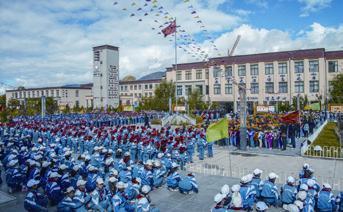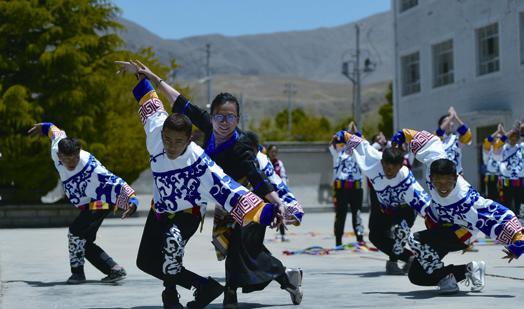ASPIRATIONAL EDUCATORS
2020-09-16ByEvanLi
By Evan Li

Having worked as a teacher and then schoolmaster for more than a decade, 38-year-old Liang Xin, a native of Beijing, made a decision in 2018 that changed the life of a group of Tibetan students and also his own.
In that year, while working in a high school affiliated with Beijing Normal University in Fengtai District of the capital, he applied to work for two years in the Lhasa Beijing Experimental School, a junior and senior boarding school with 2,500 students.
New experience
He has worked in the school for about two years, mainly focusing on school management. The school was established in 2014 with an initial investment of 220 million yuan ($32 million) from the Beijing Municipal Government. Then the capital city further invested 500,000 yuan($72,836) in 2017 to launch high-quality courses, cover tuition and offer allowances to students from registered poor households. Volunteer teachers were also sent from Beijing to support the school and currently it has 20 such teachers. Teaching results in the school have been impressive, with around 80 percent of its graduates admitted to universities this year.
When Liang first joined the school, like many other teachers from inland to support education in Tibet, he felt working on the worlds roof was not easy, as high altitude and lax school management all posed challenges. He often worked from dawn to dusk to deal with various matters, such as communicating with local teachers on reforming the management system and addressing the troubles made by mischievous students.
Although still feeling out of breath when walking upstairs at the school at an altitude of 3,650 meters, things have become much better for Liang now as his work is on the right track. He has submitted an application to continue to work in Tibet until 2022 because two years are too short to make more changes.
“My family was not supportive at first, but I insisted on the decision, because it is the right one that allows me to build up my school management and life experience,”he told Beijing Review.
Steady improvement
Over the past decades, education in Tibet, which used to be backward, has made great progress.
At the time right before Tibet was peacefully liberated in 1951, there were no modern schools, According to a white paper released by the Information Office of the State Council. Only children from noble families could enter schools monopolized by monasteries. The enrollment rate for school-age children was less than 2 percent, while the illiteracy rate was as high as 95 percent among the young and the middle-aged.
The Central Government has provided funds and dispatched teachers from inland regions to improve its education. With support of the Central Government, the regional government has improved more than 900 primary and high schools, and established 1,168 new rural kindergartens since 2016, according to the regional government of Tibet.
Since 1985, the Central Government has provided funding to cover food, shelter and study expenses during the compulsory education stage for Tibetan students from rural families and students from impoverished urban families. This policy has later been extended to benefit kindergarten and high school students, greatly boosting education.
Through these efforts, the average education attainment of the workforce in Tibet has reached 9.55 years and all school-age children have been enrolled into schools.
Since 1956, the Ministry of Education has started to send teachers from across the nation to teach in Tibet. Tibetan students have also gained access to schools in other regions starting from 1985.According to the Tibet Autonomous Region Education Department, 21 provinces and cities had classes open to Tibetan students as of August last year, with the number of students totaling around 20,000.
The arrival of teachers from inland regions in teams has allowed Tibetan students to receive high-quality education without having to leave their hometowns. After the first team of Beijing teachers went to work in the Lhasa Beijing Experimental School in 2014, the ministry initiated a project in 2016 to send 800 teachers and principals from middle and primary schools in 17 provincial level administrative regions every year to work in local schools in teams. As more such teams led by schoolmasters across China arrived in Tibet, exchanges between the non-Tibetan educators and local teachers and students were further enhanced.
Fruitful devotion
A video conference on educational assistance to Tibet held on June 12 this year revealed that over 2,000 teachers from schools and universities have worked in kindergartens, primary and secondary schools, vocational schools and colleges in the region.

Other provincial-level governments have also provided strong support for education in Tibet. Apart from Beijing, the government of Jiangsu Province in east China invested 263 million yuan ($38.3 million) in building Lhasa Jiangsu Experimental School in 2014. With 2,472 students and 20 Jiangsu educators, the school also has boarding facilities for both junior and senior high school students. The average scores of its students in senior high school entrance exams have ranked first in Lhasa in recent years.
Recently, Tibet has further stepped up efforts in developing its education. According to the regional government, it has set aside 21.24 billion yuan ($3.1 billion) for education this year, up 10.7 percent year on year. It has also improved subsidies for students from poor households and earmarked 1.14 billion yuan($167 million) for improving heating systems in local schools.
Despite the efforts of the educators, there is still a gap in students academic performances and teachers teaching quality between the Tibetan schools and those in many inland areas, said Liang.
To address the problems, Liang kept communicating with local school staff to find solutions and persuaded many people into making changes. According to him, facilities and systems have been improved, new rules have been put in place, and courses such as dancing, tennis and robotics are more accessible for students from low-income families. Moreover, with Internet technology, local students and teachers can also attend online courses given by Beijing teachers.
Yuan Liangping, a middle-aged teacher from Gaoyou City in Jiangsu, has an experience similar to that of Liang. She went to Tibet to teach local students in 2014 for the first time and then applied to have her teaching period extended to 2022.
